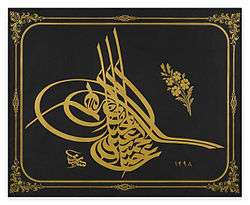Sami Efendi
| Sami Efendi | |
|---|---|
| Born |
Mehmed Sami 1837 Ottoman Empire |
| Died |
1912 (aged 74–75) Istanbul, Ottoman Empire |
| Known for | Calligraphy |
| Notable work |
 Imperial tughra of Sultan Abdulhamid II. It reads: Abdul Hamid Khan bin Abdul Majid, al-muzaffar daima. Dated 1298/1881, Istanbul. |
Sami Efendi (Ottoman Turkish: سامى افندي, Modern Turkish: Hattat Mehmet Sâmi Efendi) (1858-1912), was an Ottoman calligrapher.
Life and work
He was born Mehmed Sami on 13 March, 1838 in Haydarhâne district of Fatih in Istanbul.[1] His father was Mehmed Efendi, a steward of the quilt-makers Guild and his mother was Nefise Hanim.[2]
He was a student of Sheikh Sadik Efendi, who had learned his art in 19th-century Bukhara and his students, including Sami, helped to carry it into the 20th-century.[3] He also learned the art of paper making and the art of marbling paper by studying with Edhem Efendi.[4]
His personal style was most evident with Celî. These plates were generally written on black paper with yellow colored ink, or sometimes with gold. Sami designed the most attractive designs for vowell signs, refined many aids to reading and also developed the tezînyat (decorations) and numbers. These techniques are still in use in modern calligraphy.[5] The Tughra (monogram) found its "definitive shape" with Sami Efendi during the era of Abdulhamid II.[6]
For many years, he taught at the Topkapi Palace. His students included many calligraphers who went on to have notable careers including: Nazif Bey, Huhiso Efendi and Puza Efendi.[7]
Following the proclamation of the Constitutional monarchy, he retired. He was paralyzed in his final years and died 1 July 1912. He was buried in the Hazrat Mosque Mosque. Hacı Kâmil Efendi (Akdik) wrote his epigraph with celî sülüs.[8]
See also
| Wikimedia Commons has media related to Sami Efendi. |
References
- ↑ Uğur Derman, M., "Sami Eendi, İsmâil Hakkı", [Biographical Notes], Islam Encyclopedia, Online (in Turkish):
- ↑ Uğur Derman, M., Letters in Gold: Ottoman Calligraphy from the Sakıp Sabancı Collection, Istanbul, Metropolitan Museum of Art, 1998 , p. 142; Bloom and Blair, S.S., Grove Encyclopedia of Islamic Art and Architecture, Vol. 1, Oxford University Press, 2009, p.180
- ↑ Ocak, M., The Turks: Ottomans Vol. e 4, Yeni Türkiye, 2002, ISBN 9756782552
- ↑ Uğur Derman, M., "Sami Eendi, İsmâil Hakkı", [Biographical Notes], Islam Encyclopedia, Online (in Turkish):
- ↑ Uğur Derman, M., Letters in Gold: Ottoman Calligraphy from the Sakıp Sabancı Collection, Istanbul, Metropolitan Museum of Art, 1998 , p. 19
- ↑ Ga'bor, A and Masters, B.A. Encyclopedia of the Ottoman Empire, Infobase Publishing, 2010, p. 117
- ↑ Uğur Derman, M., Letters in Gold: Ottoman Calligraphy from the Sakıp Sabancı Collection, Istanbul, Metropolitan Museum of Art, 1998 , p. 144-45
- ↑ Uğur Derman, M., "Sami Eendi, İsmâil Hakkı", [Biographical Notes], Islam Encyclopedia, Online (in Turkish):